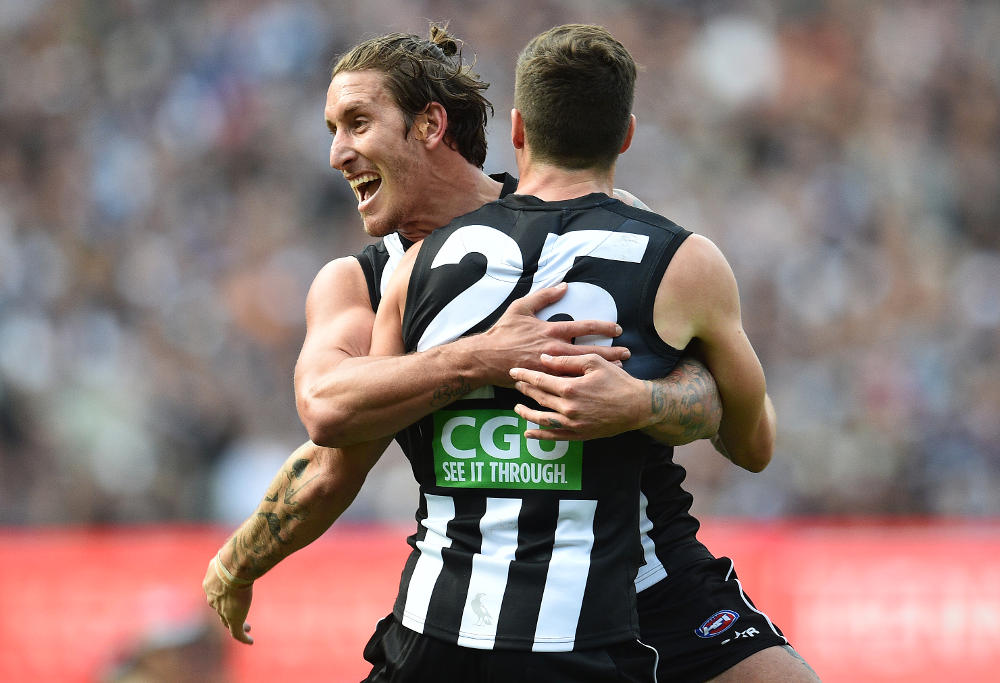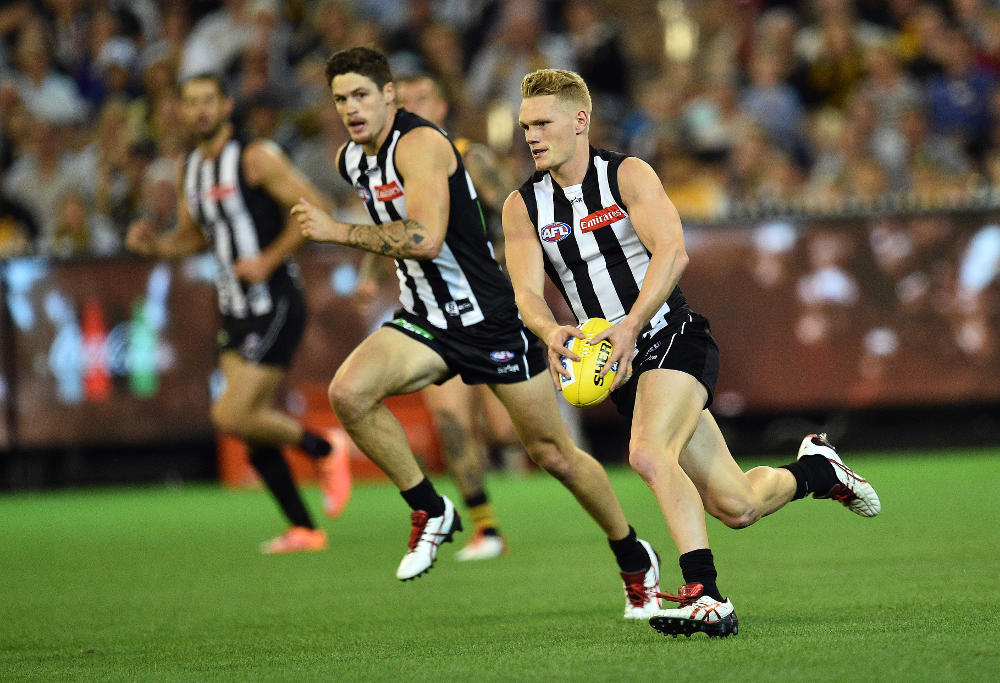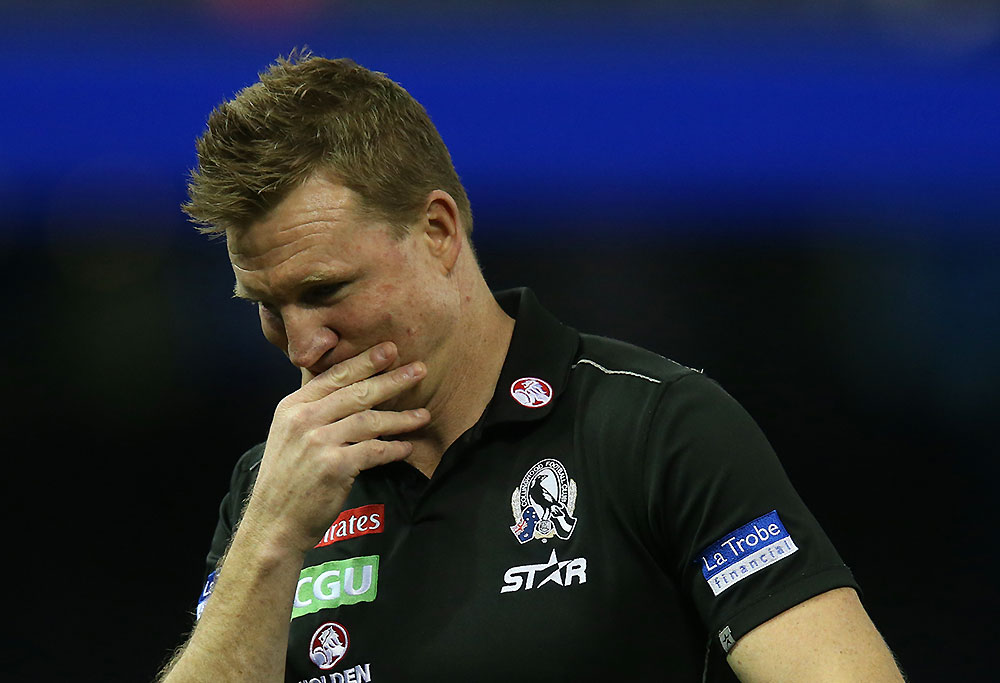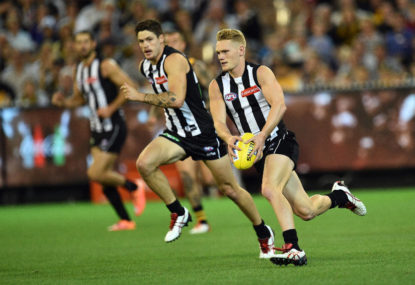Can a team with a top four midfield, top eight forward line, questionable back line and boss with a pedigree of coaching his team to more and more losses by the year surge into finals contention? We’re about to find out: welcome to Collingwood’s 2017 season.
Collingwood’s past decade can be neatly summed up in one chart.

You know the story as well as anyone that follows Australian football. Michael Malthouse joined the club as head coach from West Coast, went about building a premiership list, club president Eddie McGuire struck a coaching handover deal between Malthouse and favourite son/media darling Nathan Buckley, Collingwood won a premiership, Collingwood almost won another premiership, Malthouse left, Buckley took over, and their trajectory has been a slow, steady decent into Magpie hell ever since.
The nadir of their cycle was reached in 2016: a nine-win campaign when many – including yours truly – thought a trip to the finals was well within reach. Nine wins was a slight undershoot of the team’s actual output; this year’s number’s game showed the Pies played at a level which should have netted them 9.8 Ws.
Like fellow traditional big four member Richmond, the 2017 season looms as incalculably important for the medium trajectory of Collingwood. But unlike the Tigers, the Pies have a high ceiling, and potentially a lower floor.
It all centres on the Magpies’ midfield and forward line. There’s a non-trivial chance Collingwood have a front dozen that puts them in the upper echelon of the competition.
Last year, the Pies’ forward line was wrecked by injury and poor form. First-choice forwards Jamie Elliott (zero games), Alex Fasolo (12) and Darcey Moore (17) all missed significant parts of the season with injuries of varying severity.
Travis Cloke was absent for 22 games due to poor form (wait, he played 13 games?), while Jesse White found himself drifting in and out of the side. Collingwood played category-B rookie Mason Cox for half the season.

The team was forced to spread the forward line load, with nine midfielders booting ten or more six-pointers on the year. Levi Greenwood, god bless him, was fourth on the team’s goal-kicking list with 18 goals in 21 games. It was a bit of a mess, and it showed, with the Pies ranking 11th on my Offensive Efficiency Rating last season. It was a forward line without forward-line players.
That shouldn’t be the case this season. Collingwood purchased the services of Chris “Provides a Contest” Mayne to fill Travis Cloke’s spot at centre half forward. While Mayne isn’t a top-flight tall, he is at worst as competent as Cloke and offers more as a ground ball player. Tackles are a bit of a nothing stat because of the different contexts, but it is worth noting the differential between Mayne (5.4 tackles per game) and Cloke (2.2).
Coming into the year it has to be assumed Elliott, Fasolo and Moore are over their injury worries. That means guys like Jarryd Blair and Ben Crocker will be relegated to backup roles. White can be released to play as a very high-half-forward-almost-winger role to take advantage of his limited skill set. Travis Varcoe completes a front six as a rotating half forward midfielder. The flow on impacts could be immense.
Questions remain, though.
Moore has played just 26 games, and his flashes of brilliance have been just that. Elliott and Fasolo have played 81 and 72 games, respectively. Mayne and White provide some stability, but reliability should only be a trait of the bottom half of a starting line-up. If it works, the unit’s unique skill combination (marking smalls and ground game talls) is loaded with potential.
Collingwood’s forward line might not be as potent on paper as the very best in the game, but it should intrigue us all greatly.
The team’s midfield is undisputedly at that elite level, particularly following the addition of a 15-game-a-year Daniel Wells. The continued development of Taylor Adams, Brodie Grundie and Adam Treloar, who are all entering their 24-year-old seasons in 2017, should see them all peak, together, in the next two years.
The unit’s depth has been built gradually over the past few seasons, with Levi Greenwood, James Aish and Jack Crisp joining from other clubs in recent years. Former Greater Western Sydney Giant Will Hoskin-Elliott is another Magpie that began his career at another club who can be expected to play a role in the starting line-up this season.
Last year, I called Collingwood’s group a top six midfield, and it’s hard to argue it has got worse in the off-season. The addition of Wells adds an interesting dimension to a group who has been rightly criticised for generally poor disposal quality – not necessarily measured by disposal efficiency, which the numbers say Collingwood was the sixth-best on this measure last season – in the past two years.
Despite the on-paper strength of their midfield, the Pies have been unable to generate much of an advantage over the past two seasons. Last year Collingwood broke even on the inside 50 count (they had a differential of 0.0 on the year), and could only muster a below-average 51.4 entries themselves. The team lost the time in possession count by an average of two minutes per game.
In wins, Collingwood’s time in possession differential was 4.5 minutes per game – in losses that collapsed to -6.3 minutes per game. Their inside 50 differential was similar in magnitude, albeit was caused by four games that the Pies smoked their opponents.

Part of this comes to scheme. The Pies play a hard press, which has slowly been knocked on the head as a dominant strategy in the past two years. It requires a maniacal commitment from the players to make it work effectively, and for one reason or another there were many points in the past few years where that commitment has wavered. Now the Collingwood midfield is approaching maturity, Buckley should free things up a bit and let Pendlebury and co play with more freedom. We’ll see.
And again, coming into the year, there are loud questions being asked about Wells’ fitness and ability to play out a season. Collingwood’s midfield will do just fine in games that Wells doesn’t play, but they look set to be a better team when he does. Nathan Buckley recently said the Pies would be happy to get 15 games a year out of their new recruit; Collingwood must be judicious as to when they roll Wells out if that is their attitude.
Speaking of injuries, are there two more important body parts on the Collingwood list than Ben Reid’s legs? The Pies have ushered in a lot of change to their backline, losing Nathan Brown, Jack Frost and Marley Williams in the off-season and bringing in Melbourne’s Lynden Dunn.
Jeremy Howe is now almost certainly a full-time defender on this list, after a very strong year as an intercepting half back. The returning Lachie Keefe could break into the starting line-up by the end of the season if he is able to establish himself as a modern 200cm key defender in the mould of Jake Carlisle in the VFL this season.
Ben Reid is unquestionably the leader of the group and the only key defender with a pedigree of consistently good defensive play. Again, the Pies performance might just hinge on the ability of Reid to play 20 or more games and avoid a season-threatening injury.
On paper, the Pies are looking stacked in the midfield, promising up forward, and a little shaky backward of centre. This isn’t a conventional recipe for success; most pundits will tell you having a strong defence is the first step towards a higher plane. That’s how Malthouse climbed the mountain, although his conservative ball movement and introduction of the press was more the factor there.
Collingwood under Buckley look to be building a team more tuned for attack, which looks a sound strategy given the meta-game within the AFL is shifting towards a bias for action rather than inaction. The doubt creeps in when you consider the injury histories of Wells, Reid and now Elliott, three players in critical roles.
The heat is on early. Collingwood face the Western Bulldogs and Richmond at the MCG to open the year, travel to Sydney and then across town to play St Kilda. It is a remarkably similar slate to last season’s opening four rounds, which went Sydney (A), Richmond (H), St Kilda (A, but at the ‘G) and Melbourne (H). The Pies went 1-3 and never really recovered.

If Collingwood are going to assert themselves in the race for finals, competitive showings against the Dogs and Sydney, and victories against St Kilda and Richmond, are hurdles that must be cleared. The Pies have a mixed fixture this season, with just one trip to face a 2016 finalist (GWS), 14 games at the MCG, but double ups against Geelong and Hawthorn (as well as Essendon, Melbourne and Port Adelaide).
In this respect, Collingwood fans and AFL aficionados should get a reasonable sense of whether the Pies are in contention for September in the first month of the season. Should they split the ledger, or go one up, then the push for finals is on – if their finely tuned machine can stick together.
But what if they fall on their collective face once more?
It won’t dent the Magpies’ President Eddie McGuire, who was just reconfirmed as Collingwood’s president for three more years. His tenure as Collingwood’s chairman will stretch into a third decade by the end of his current term. To date, it has yielded plenty of off-field success, but an on-field winning percentage of 53 per cent, ten finals campaigns, three grand finals, one premiership and one orchestrated coaching handover.
When Nathan Buckley took over as Collingwood coach, the consensus was had been gifted the keys to a multi-year dynasty. It is one of the AFL’s great counterfactuals; what would have happened if Malthouse had remained, Collingwood hadn’t broken its 2010 premiership team up and continued to age together as a unit.
Should Collingwood’s season fail to show progress – another year of growth in the loss column would be instantly fatal – and result in Buckley falling on his sword, it must surely rankle the fan-base enough to cause some unrest. What becomes of that unrest remains an unknown.

































































































